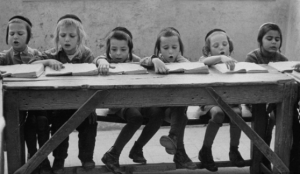Some say the aural-input-based Hebrew instruction I’m championing may very well represent a departure from our 4,000+ year old Jewish tradition of prioritizing literacy – of teaching Jewish content through Hebrew texts.
Not so, I protest. It’s just that starting with Hebrew writing is putting the cart before the horse.
My father and his father before him attended a Hebrew school (or ‘cheder’) whose sole purpose was to get the students decoding Hebrew, well and fast enough to daven (pray) from a siddur (daily prayer book). It’s purpose wasn’t explicitly to understand the prayers therein – not even their main ideas – and certainly not their constituent words. It was to engrave the order and content of daily and holiday prayer into the collective memory of the next generation. Not a small or insignificant undertaking. And it was quite effective. My father, Saul Shapiro, ז׳׳ל, davened fluidly and could read the prayers accurately, even though as a busy doctor and parent of four he rarely attended synagogue. I used to love watching his whispering lips as he sailed through the quiet, meditative prayers during high holiday services.
But we must ask ourselves now, what do we want from our kids’ Hebrew/Jewish education? And what do our kids want and need?
We have the benefit of brain science and evolving language pedagogy, not to mention a vast cultural shift, allowing and inviting us to search for meaning in our Hebrew and religious school offerings. If we want only to prepare our students for traditional life-cycle events such as as bar/bat mitzvah or confirmation, and how to blast through a holiday מחזור, then the status quo of starting (and ending) with Hebrew texts gets the job done, I guess…. But many a Hebrew school student (and traditionally taught French, Spanish or other World Language student) complains about taking 4+ years of language class with NOTHING – NO USEFUL RETENTION to show for it.
Most of us want more, and more importantly, our kids want more. Not more work or aggravation. More meaning. Less drudgery. Inherited traditions and liturgy are cloaked in a veil of Hebrew mystery to less-observant Jews who don’t attend day-school. So how can we make them more visible, comprehensible and meaningful?
We need to front load tons of oral Hebrew understandable input before setting our kids to the task of Hebrew reading. This is the proverbial horse.
Just as our toddlers were drenched in oral language before we taught them the letters, their sounds and words they form, so we must flood our Hebrew school students with interesting and understandable aural messages in Hebrew, if we want them to recognize, and attach meaning to the words and sentences we later ask them to decode and read.
Will the simple, high-frequency-verb-filled scenes and stories we create and later read in Comprehensible Input-based Modern Hebrew class transfer to comprehension of ancient prayer texts? Not entirely – but there will be some overlap. Students may begin to see other forms of familiar verbs (i.e. אומר – ויאומר) – and deductively make connections based on verb roots. They’ll see familiar prefixes & suffixes, articles, connection & transition words.
But my practical question, as a Modern Hebrew language enthusiast and instructional reform advocate, is this: What are the odds that someone who can decode the prayers but not understand any of them, will continue seeking more comprehensible Hebrew input, which will inevitably lead to more acquisition? Will they even see a connection between the prayer words they can read, and the living breathing Modern Hebrew language?
Compare those unfavorable odds to the kid who’s been exposed to plenty of comprehensible auditory input, and has enjoyed pleasure and success in a meaning-centered Hebrew CI class, chock full of conversational exchanges. Put a prayer text in front of her and ask, “Do you understand this?” Depending on the CI-taught kid’s ability/level, she may extract some nuggets of meaning. Even if she doesn’t yet understand the antiquated and stilted prayer text before her, she’ll still come back for more CI, because it’s fun, its effective and success begets success! Keeping our kids in the Hebrew game is crucial. Getting exposure for only an hour or so per week (in supplementary school) or 3.5 hours (in a public high school elective program) is slow going toward proficiency. I’ll opt for Plan B, with Comprehensible Input instruction affording a greater likelihood of longer-sequence and more pleasant engagement with my students.
Hebrew text is important and, many would argue, the epicenter of our tradition. Reading is the single most effective way to grow one’s language acquisition. But the order is crucial, particularly for beginners: Slather on the aural input – drench and soak in quality, compelling comprehensible messages. THEN, read, rinse, and repeat.
Let’s put the listening horse back where it rightfully belongs: Before the reading cart.

I’m glad and relieved that you’re embarking on this at TBI. I had the sense but no words to describe what you’ve so eloquently written. I look forward to learning from my kidlet and from you through your blog.